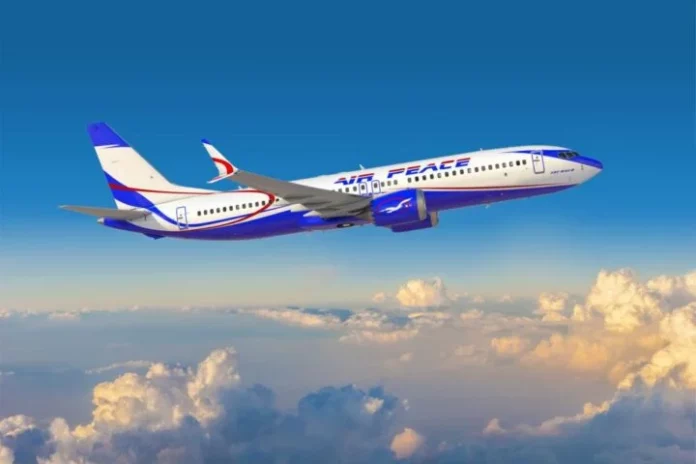Air Peace Airlines has issued a firm rebuttal to the viral rumors circulating on social media that one of its planes was involved in a deadly crash in the Western Sahara region. The airline’s response, made public on December 27, 2024, sharply criticized the claims as not only false but also malicious, designed to tarnish its reputation and safety record.
The viral rumors began on December 26, when a user on the social media platform X (formerly Twitter) alleged that an Air Peace aircraft had crashed in the desert region, resulting in the deaths of 50 passengers, including a prominent individual. The rumors quickly gained traction, as accompanying images of the alleged crash site were widely shared.
In a statement released by the airline’s Head of Corporate Communications, Dr. Ejike Ndiulo, Air Peace denounced the rumors as part of a “deliberate attempt to spread misinformation” and stated that the report lacked any basis in fact.
“We categorically state that this information is false and malicious,” Dr. Ndiulo wrote, emphasizing that the airline had not been involved in any such incident. “This is a deliberate attempt to spread misinformation and tarnish the impeccable safety record of Air Peace.”
Dr. Ndiulo also addressed the images that accompanied the false reports, asserting that they were AI-generated, which means they were fabricated by artificial intelligence and did not reflect any real-life events. He added that the images had no connection to any actual incident involving Air Peace.
“We want to make it clear that the images being circulated are not genuine. They have been fabricated using AI technology,” Ndiulo said. “These fabricated images and false reports are intended to cause unnecessary panic and alarm among the public.”
The airline also called out the individual behind the social media post, pointing to their history of disseminating false and sensationalist content. Dr. Ndiulo did not identify the person by name, but he made it clear that they had previously been involved in spreading similar false claims.
“It is important to note that the author of this post has a history of disseminating false and alarming information about nonexistent tragic incidents,” the statement continued.
According to Air Peace, the public should be cautious and avoid spreading unverified reports from unofficial sources. The airline stressed the importance of relying on official communications and confirmed that it had no flights scheduled for the region in question.
“The public should disregard this malicious disinformation and rely on official channels for accurate information regarding Air Peace operations,” the statement concluded.
AI Technology and Its Role in Modern Misinformation
The spread of false information fueled by AI-generated content is becoming an increasing concern, not just in the airline industry but across various sectors. AI tools, such as deepfake technology and image generators, have made it easier for individuals with malicious intent to create realistic-looking but entirely fake visuals.
While many AI-generated images and videos are used for entertainment or artistic purposes, their potential for harm has been highlighted in various recent incidents. In the case of Air Peace, these AI-generated images were designed to look like real-life photographs of a crash scene, giving the hoax a deceptive level of credibility.
Experts have warned that as AI technology improves, distinguishing between real and fake images and videos will become even more challenging. The ability of AI to create convincing visual content means that misinformation can spread faster than ever before, with serious consequences.
Airline Safety Record and Public Trust
Air Peace, one of Nigeria’s leading airlines, has long prided itself on its commitment to safety and passenger welfare. The airline has consistently maintained a strong safety record, making the accusations particularly damaging. The airline’s spokesperson, Dr. Ndiulo, took the opportunity to reassure the public of its ongoing commitment to maintaining the highest safety standards in the industry.
“Air Peace has always prioritized the safety of our passengers and staff, and we continue to uphold that commitment in every aspect of our operations,” Dr. Ndiulo stated. “We have a strong record, and it will not be tarnished by baseless rumors.”
The airline’s swift and decisive response to the hoax is a reminder of the importance of transparency and clear communication in handling misinformation. In an era where digital content can easily be manipulated and disseminated, public figures and organizations must act quickly to safeguard their reputation and maintain public trust.
The Growing Challenge of Social Media Misinformation
This latest incident underscores the growing challenge of misinformation in the digital age. Social media platforms like X, Facebook, and Instagram have become key channels for the spread of information, but they are also prime venues for the rapid dissemination of rumors and false claims.
Experts agree that social media companies have a responsibility to address the spread of misinformation more effectively. However, despite efforts to curb false content, the speed at which rumors spread often outpaces the ability of fact-checkers to debunk them.
The Air Peace hoax also raises questions about the responsibility of users who post and share information. While the airline was quick to debunk the false claims, many individuals had already shared the misleading images and text, further amplifying the reach of the misinformation.

